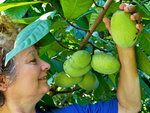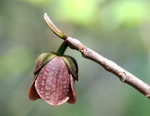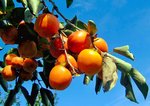



What is the best fruit tree to grow in the Cape Fear region? I have given 40 years of thought to this issue, and the answer is in. Can you guess the result?
It’s not peach, not apple, not plum.
It’s pawpaw.
Huh? Yep, pawpaw trees.
The native pawpaw tree is covered in mid-August with fruits that can exceed 1 pound each. The fruits are the largest and sweetest of any fruit tree native to the United States.
Because they are native, pawpaws need no spraying, little watering and no protection from late freezes. They may need a little fertilizer after they start growing. I haven’t fertilized mine in many years, but I think I will give them a little organic fertilizer this spring.
The trees produce small, drooping flowers in early spring. The flowers are green and mature to dark purple.
In fall, the drooping, 6-inch leaves turn a rich shade of buttery yellow. The effect in the landscape can be stunning.
The tree does have a few drawbacks:
• The fruits must be peeled, but the thin peeling comes off easily.
• The roots send out runners that come up as new trees. So, plant where you can mow around the tree and you won’t have to pull up the deeply rooted runners.
• The tree needs a couple of hours of shade each day. Full sun in a hot, sandy, open field will produce poor growth.
• It needs water in dry spells that last more than 10 days.
• It has large seeds, twice the size of watermelon seeds. You can remove them before eating. I just spit them out.
• The richly nutritious fruits are very high in sugars. That’s not good for diabetics. I limit my intake to one or two a day.
• You do not pick pawpaws. You pick them up. The fruit decides when you can eat it. There is a nursery rhyme that goes: “Pickin’ up pawpaws, puttin’ them in the basket.”
Fruits fall when they are fully ripe. Then you have to eat them fresh within two days — three or four if you refrigerate. You can freeze them, and they are best eaten like ice cream. Just spoon out the fruit and leave the seeds.
The trees are best planted when they are dormant.
I was given my first pawpaw 40 years ago by a devoted customer at my daylily farm. She had brought several seedling plants with her when she moved to Fayetteville from Michigan. I planted it in too much sun, and it grew poorly for the first two years. Then I moved it to a spot lightly shaded by a tall, longleaf pine. It is now more than 20 feet tall.
For the first 15 years I had this tree, it bore no fruit. It needed a pollinator. No pawpaw trees will bear fruit unless you grow two genetically different trees. So about 17 years ago, I bought another pawpaw called ‘Anderson.’ I would have bought a pollinator sooner if I had known how awesome the fruits are with them.
Within two years, I began to get dozens of pawpaw fruits yearly. You can’t market them because they don’t keep long enough to get to the supermarket in edible condition. My wife, Maureen, and I eat very few, so I invited as many people as I could to come pick them up and eat them.
I stopped doing that after four years because I found a couple who would take all the fruits I had, grow the seeds and sell the plants themselves.
That couple is Monika and Lacy English. They live in Fayetteville. I’m guessing they have few plants for sale right now because they sell out every year.
You can call them at 910-867-7211.
The trees are becoming popular and are widely available on the internet. Two good internet sources are logees.com and willisorchards.com.
What came in second?
Japanese persimmons came in second. Nothing could be further from a pawpaw, at least geographically. They share in low maintenance.
Japanese persimmons come in two types. One is flat-formed and has no bitterness. Even when it is still as crunchy as an apple, it is very sweet. The other, like our native persimmons, is bitter until fully ripe. It should be left on the kitchen counter or refrigerated until very soft. Then it is perhaps even sweeter than the first type. The bitter type is up to one-third larger than the Fuyu or sweet type.
Both types are very large. A 12-foot tree can have 50 or more fruits that could cost $1 each in the supermarket. And they hang on the tree until after the leaves fall. The effect is striking. Imagine 50 or 60 orange-colored tomatoes hanging on a leafless tree.
The leaves are spectacular, too. They turn bright orange to orange-red in fall.
Both types are grafted. Check the grafts yearly to be sure they are still healthy and not separating. Japanese persimmons will grow well in full sun to a little shade.
Eastern N.C. is fertile ground for many kinds of fruit trees
Pawpaws are not the only choice if you want to pick fresh fruit off your backyard trees.
Allen West, an agent in consumer horticulture with the Cumberland County office of North Carolina Cooperative Extension, says fruit trees recommended for eastern North Carolina include apple, fig, pear (Asian and European), persimmon (American and Asian), and plum.
“Eastern N.C. has several challenges for apple trees that stem from our warm climate,” West says. “For example, you can grow apples in eastern N.C., but they may not have as bright and attractive color as those grown in the western part of North Carolina and have more disease pressure than in other climates.”
West says apple varieties such as Golden Delicious, Red Delicious, Gala, and Stayman are recommended for North Carolina.
Fig varieties that do well include Brown Turkey and Celeste, he says.
“For plums, Methley and Byrongold are varieties that do well,” West says. “Also, for persimmons, Fuyu and Jiro are good choices.”
West says peach and apple trees can be grown here, but they come with many challenges because of the climate.
“One of the challenges with growing fruit trees in eastern N.C. is because of our warm, humid summer weather and frequent rains, which make conditions favorable for certain diseases,” West says. “Fruit varieties that are more suited for warmer and humid climates are recommended.”
Before planting fruit trees, West advises, consider the mature growth and give ample space between other trees and buildings.
“Dwarf or semi-dwarf trees take up much less space and can be good options for backyards or landscapes,” he says. “Fruit trees like full sun and will need to have a water source in times of drought.”
West recommends a soil test before planting. Test boxes are available at the extension office.
When planting a tree, West says, a good rule of thumb is to dig the hole the same depth as the root ball of the tree and twice as wide as the root ball. Stake young trees until the roots become established.
Proper pruning of fruit trees will increase fruit production, West says.
So how long after planting will your fruit tree produce?
“This depends on the type of fruit,” West says. “Some fig trees can bear ripe fruit within three years, while apples, pears and plums can take between four to six years to bear fruit.”
West says fig trees are his favorite because they are easy to maintain and “provide delicious fruit.”
Fruits of your labor
Consumer Horticulture Extension Agent Allen West will lead a workshop titled "Sustainable Home Fruit Production" with David Cline of N.C. State University. It is scheduled at 9 a.m. March 11 at the N.C. Cooperative Extension center auditorium at 301 E. Mountain Drive.
Registration and a fee of $20 are due March 8. Register at Eventbrite.
For information, go to https://cumberland.ces.ncsu.edu.